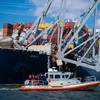Last December, Ulstein Verft AS won the contract to convert shipowner Solstad’s cable-laying vessel Normand Clipper into a pipe-laying and offshore construction vessel. The conversion work is as extensive as the building of a new platform supply vessel.
Rebuilding will be finished by the end of May, at which time the vessel will go straight to work in the English sector.
“The conversion is extensive, and the work involved for Ulstein can be compared to that required for the construction of a new platform supply vessel. The entire work process is to be finished within the course of five months. Preparatory work began in December 2004, when the rigging and cable-laying equipment was brought ashore. Bunkers still inside the vessel were removed, and the tanks drained of gas. In January this year, work began to cut away the hangar, remove equipment and build sections, but shipyard workers could not fully begin the work until mid February. By that time,” says Lidvar Lillerovde, Project Manager at Ulstein Verft, “the vessel had entered dry dock”.
“The yard has assigned many workers to the task and there is the ability and determination to deliver on schedule. In addition to this, the charterer has made a number of requests during the conversion process, which have led to minor modifications being carried out - these demands have been tackled on the spot”, says Captain Erling Sandviknes of Solstad. He stresses how crucial it is for shipowners that a vessel is delivered on schedule, as in many cases, the vessel is under contract to enter service immediately after construction.
Prepping for the Crane
Normand Clipper will have a 250-tonne heave-compensated offshore crane mounted in August. Ulstein Verft will erect the crane pedestal and carry out preparatory work to enable the crane to be mounted on the port side of the vessel. A new transformer and switchboard room, which ensures the power supply for the crane, has also been installed. The 25-tonne crane which used to stand on the port side has been relocated to the starboard side, and has been upgraded for work down to a depth of 500 m.
The vessel used to accommodate a crew of 70. That capacity is adequate for pure pipe-laying assignments, but more hands are needed for the more demanding construction jobs.
“This challenge is met by the upgrading of existing accommodation, and by extending the superstructure towards the stern. We have put in extra cabins, an ROV hangar for remotely controlled mini-submarines, an ROV control room, an office and a conference room. We will now be able to accommodate a crew of 102. We have also fitted new life-boats and davits to comply with the NIS requirements for crews of this size”, Mr Lillerovde says.
The vessel has increased its breadth from 23.4 to 27 metres by adding sponsoons - tanks along the sides of the vessel.
“These sponsoons are drawn right up to the wheelhouse midships”, says the Project Manager.
“The sponsoons extend the deck sideways, accommodating bulky deck equipment such as pipe carousel, but they also compensate for the readjustment of weight that is required when the largest crane is swung over the ship´s side. As a consequence of the sideways extension of the vessel, new crane base, ROV module and living modules, the added weight of new steel in the hull is estimated at approximately 1300 tonnes”.
“For the vessel being capable of carrying a full load of pipes and equipment for pipe-laying and construction work, the working deck had to be reinforced. We have halved the distance between ribs and strengthened several decks. While the deck could previously support 3 tonnes per square metre, it is now able to support 10 tonnes per square metre”, says Mr Lillerovde.
“A moon pool has been installed in the deck to enable equipment to be lowered down for subsea operations. For such assignments, the vessel must have strong motors and propellers, as well as a dynamic positioning system (DP) which guarantees the vessel’s positional stability, regardless of weather or conditions at sea. The vessel was already equipped with a DP2 system, but this has been upgraded with new reference equipment and other features. In order to manage construction and pipe-laying assignments, the bridge has been rearranged; the DP desks on the bridge have been moved aft, and new manoeuvring desks have been fitted in aft for complete control. With future demands from authorities in mind, we have also mounted a Voyage Data Recorder (VDR) on the bridge, which processes signals, through 70 different cables, from all machinery onboard”, he says.
The converted Normand Clipper is due to leave Ulstein Verft in the end of May this year, bound for Newcastle, where the vessel will report for duty on four assignments for Technip Offshore.
“We will take on board two ROVs and four drums for umbilicals and flexi pipes”, Captain Sandviknes says. He explains that “umbilicals” are cables which provide sub-sea and other installations with among other hydraulic, fibre optic and electric power. Flexi pipes are designed to conduct gas and oil between installations on the sea bed.
“Three of the assignments are inside the English sector, and involve laying umbilicals and flexi pipes. The key project is the laying of the principal umbilical from Melkøya off Hammerfest, Norway, and out to the Snøkvit oil field. We will have a 20-metre diameter carousel mounted for this assignment, around which we will wrap the umbilical. This assignment will last just under a month and a half”.
These assignments will come to an end around mid August. The vessel will then head for Kristiansand, Norway, where National Oilwell will deliver and mount the fully integrated 250-tonne crane.
“The crane will undergo testing, after which we will probably begin another assignment which will take us up to the 1st of November. As of that date, we will have a 180-day contract with the Australian company, Clough Ltd. We will take onboard complete deck equipment, i.e. eight flexi-pipe rails and new ROVs. Thereafter, we head for the East coast of India to lay flexi pipes. The agreement with Clough Ltd. contains an option to extend the agreement for up to five more years, in direct continuation of the fixed period”, Mr Sandviknes says.
“The sister ship, Normand Cutter, was converted at Ulstein Verft in 2004, and is a true success story. She has been on continuous assignment since she left the yard last May. We onboard the Normand Clipper are aware of a large interest in our vessel. Clough Ltd. came along with the first long-term contract. There are not many vessels in the market offering the capacity of a 250-tonne crane. Over the next three years, several interesting projects within the pipe-laying and construction markets are to be allotted, in several new fields. We will be actively competing for some of these projects, the Captain assures us.
Sponsored Content
Chris-Marine’s solutions help to prolong engine lifetime

AST is now AST Networks, bringing you remote connectivity wherever you are

March 2024
 Read the Magazine
Read the Magazine

 Read the Magazine
Read the Magazine
This issue sponsored by:

Dredging: Plenty of Issues, New WRDA on the Way
Subscribe for
Maritime Reporter E-News
Maritime Reporter E-News is the maritime industry's largest circulation and most authoritative ENews Service, delivered to your Email five times per week












